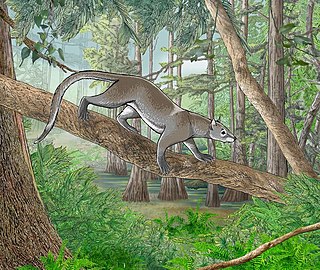Boffius is a genus of mammal from the Paleocene of Europe, which was named by Vianey-Liaud M. in 1979. It is a member of the extinct order of Multituberculata.
The Thanetian is, in the ICS Geologic timescale, the latest age or uppermost stratigraphic stage of the Paleocene Epoch or Series. It spans the time between 59.2 and56 Ma. The Thanetian is preceded by the Selandian Age and followed by the Ypresian Age. The Thanetian is sometimes referred to as the Late Paleocene.

Viverravidae is an extinct monophyletic family of mammals from extinct superfamily Viverravoidea within the clade Carnivoramorpha, that lived from the early Palaeocene to the late Eocene in North America, Europe and Asia. They were once thought to be the earliest carnivorans and ancestral to extant ones, but now are placed outside the order Carnivora based on cranial morphology as relatives to extant carnivorans.

Miacis is an extinct genus of placental mammals from clade Carnivoraformes, that lived in North America from the early to middle Eocene.

Vulpavus is an extinct paraphyletic genus of placental mammals from clade Carnivoraformes, that lived in North America from the early to middle Eocene.

Palaearctonyx is an extinct genus of omnivorous placental mammals from clade Carnivoraformes, that lived in North America from the early to middle Eocene.

Adapisoriculidae is an extinct family of non-placental eutherian mammals which was present during the Paleogene and possibly the Late Cretaceous. They were once thought to be members of the order Erinaceomorpha, closely related to the hedgehog family (Erinaceidae), because of their similar dentition, or to be basal Euarchontans. They were also thought to be marsupials at one point. Most recent studies show them to be non-placental eutherians, however.
Deccanolestes is a scansorial, basal Euarchontan from the Late Cretaceous (Maastrichtian) and Paleocene Intertrappean Beds of Andhra Pradesh, India. It may be closely related to Sahnitherium. Deccanolestes has been referred to Palaeoryctidae in the past, but recent evidence has shown that it is either the most basal Euarchontan, as the earliest known Adapisoriculid, or as a stem-afrotherian.

Palaeochiropterygidae is a family of extinct bats. It was originally erected by the Swiss naturalist Pierre Revilliod in 1917 after discoveries of Palaeochiropteryx fossils from the Messel Pit of Germany. Palaeochiropterygidae was merged into Archaeonycteridae by Kurten and Anderson in 1980, but modern authorities specializing in bat fossils maintain the distinction between the two. It was classified to the unranked clade Microchiropteramorpha by Smith et al. in 2007.
Proremiculus is an extinct genus of adapisoriculid mammal known from the Paleocene of Belgium.
Afrodon is an extinct genus of eutherians in the family Adapisoriculidae. Its type species is Afrodon chleuhi, known from the late Palaeocene of Morocco. The other known species are Afrodon germanicus from the late Palaeocene of Germany and France, Afrodon tagourtensis from the early Eocene of Morocco, Afrodon ivani from the late Palaeocene of Spain, and Afrodon gheerbranti from the early Paleocene of Belgium. Its range spread from the Cernaysian to the Grauvian in the European land mammal ages.
This paleomammalogy list records new fossil mammal taxa that were described during the year 2012, as well as notes other significant paleomammalogy discoveries and events which occurred during that year.

Dormaalocyon is an extinct genus of placental mammals from clade Carnivoraformes, that lived in Europe during the early Eocene. The type species, Dormaalocyon latouri, was discovered when fossils were unearthed in the village of Dormaal, near Zoutleeuw, in the Belgian province of Flemish Brabant.
The Conglomérat de Cernay is a geologic formation in Champagne-Ardenne, northern France. It preserves fossils dating back to the Thanetian stage of the Paleocene period. The lizard Cernaycerta and placental mammal Bustylus cernaysi are named after the formation.
Matthesia was a primitive bat genus in the family Palaeochiropterygidae. Matthesia is represented by two species known from the middle Lutetian of Geiseltal, Germany. It may be a junior synonym of Palaeochiropteryx.
Orthaspidotherium was a European Paleocene genus of early herbivorous mammals of the family Pleuraspidotheriidae. It was included in the family Meniscotheriidae by Teilhard de Chardin in 1921-1922 and was subsequently separated into the family Pleuraspidotheriidae, before being placed in the family Phenacodontidae. The first complete skull of O. edwardsi was described in 2010, and the same paper once again places it in Pleuraspidotheriidae. A 2017 study further reiterates this view.

Onychonycteridae is an extinct family of bats known only from the early Eocene of Europe and North America. The type species, Onychonycteris finneyi, was described in 2008 from two nearly complete skeletons found in the Green River Formation of southwestern Wyoming. Since that time a number of previously described fossil bat species have been assigned to Onychonycteridae, as well as two more recently discovered species.
Chiromyoides is a small plesiadapid primatomorph that is known for its unusually robust upper and lower incisors, deep dentary, and comparatively small cheek teeth. Species of Chiromyoides are known from the middle Tiffanian through late Clarkforkian North American Land Mammal Ages (NALMA) of western North America, and from late Paleocene deposits in the Paris Basin, France.

Arctocyonians are a clade of laurasiatherian mammals whose stratigraphic range runs from the Palaeocene to the Early Eocene epochs. They were among the earliest examples of major mammalian predators after the Cretaceous–Paleogene extinction event. While some classify arctocyonians as stem-artiodactyls, others have classified the group as members of Ferae. There are three families classified in the order: Arctocyonidae, Oxyclaenidae, and Quettacyonidae.

The Amphilemuridae are a family of extinct mammals belonging to the order Eulipotyphla, from the Eocene of Europe and North America.













